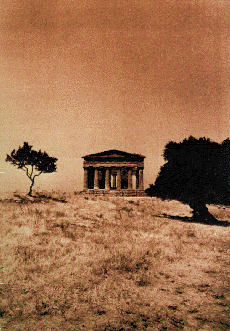Cultural
programme of the Goethe-Museum
 |
Frank Horvat: Goethe in Sicily Photographs to the
texts of the "Italian travel"
The
exhibition in the "Arkadensaal" shows 20
photographs of Frank Horvat (*in 1928 in Abbazia/Istria),
made in the early eighties dealing with Goethe's travels
through Sicily (in 1787). Horvat has selected the
subjects of his photographs so that the visitor of the
exhibition will be able to retrace the central
constellations of Goethe's travels through Sicily: his
fascination for the sensuous quality of the scenery, his
interest in geology and mineralogy, his reflections on
the primitive plants as well as his thoughts on the
manierismus and religiousness of the people. A catalogue
with the pictures and texts of the exhibition is
available.
|
Permanent
exhibitions
The young
Goethe in Frankfurt
Location:
Goethe-Haus
In Goethe`s birth
place the atmosphere of a middle class 18th century
home can be experienced. On the ground floor visitors will see an
ancient kitchen and the dining room. On the first floor the
living room, music chamber, library and the picture gallery of
Goethe`s father can be seen On the third floor Goethe`s
puppet-show and his study are on display. Also on display are
items recording the family`s daily life, Goethe`s youth and his
early writings.
Gallery of
the Goethe era
Location:
Goethe-Museum:
Paintings and
sculptures dating back to Goethe`s era (1749-1832) displayed in a
14 room exhibition record the development of German art from late
Baroque to early Romanticism. The underlying idea of this
exhibition is Goethe`s lifelong interest in the arts. The
exhibition`s earliest pieces are works by Trautmann, Morgenstern
and Schütze the elder. The dramatic compositions by Füstli
represent the ´Sturm und Drang` era, while the psychologising
portrays by von Graff are connected with the Enlightenment. The
experiences Goethe gathered on his Italian journey are
encapsulated in paintings by Tischbein, Hackert and Angelica
Kauffmann. While the poet`s conflict with romanticism is
reflected in the landscape drawings by Friedrich and Carus.
